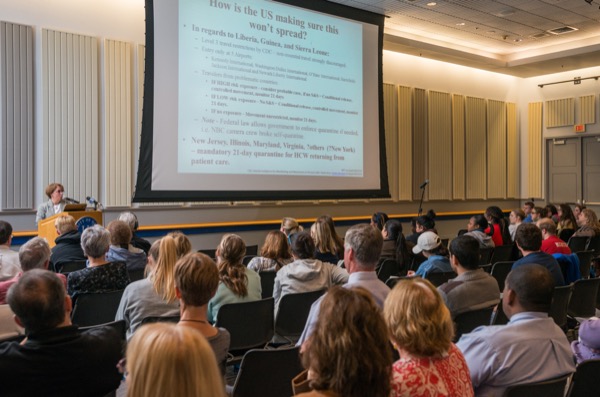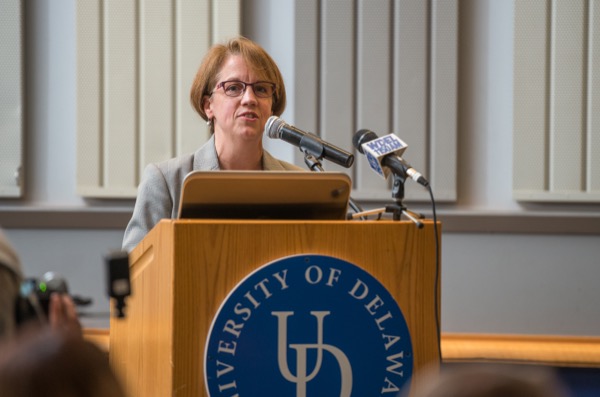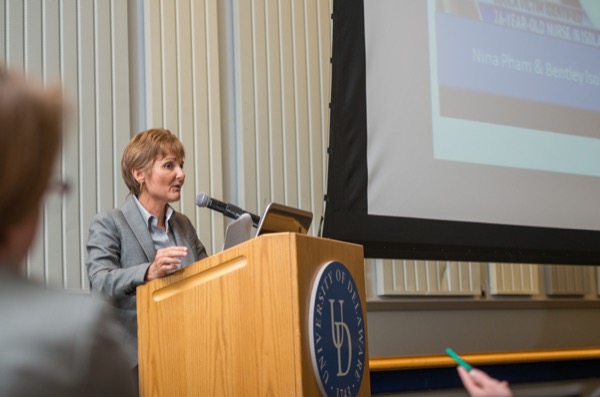


Learning about Ebola
UD faculty members provide details about Ebola virus, how it spreads
4:06 p.m., Oct. 29, 2014--Though the Ebola virus outbreak is the largest ever and continues to make front-page headlines, members of the University of Delaware faculty explained that the U.S. health care system is capable of identifying and treating the disease.
Michelle Parent, associate professor of medical laboratory sciences, along with colleagues Diane Rudolphi and Jessica Madiraca, both of the clinical medical surgical nursing faculty, detailed the latest medical findings on the Ebola virus during a presentation on Tuesday evening, Oct. 28, in the Trabant University Center.
Campus Stories
From graduates, faculty
Doctoral hooding
Parent, who also is an expert in immunology and infectious disease, told the audience of about 100 members of the UD and surrounding communities that the while the Ebola virus outbreak is a serious international health care concern, the risk of contracting the virus in America is minimal.
“The chance of contracting the Ebola virus in America is about 1 in 13 million,” Parent said. “This compares to 1 in 5,000 chance of contracting the virus in Monrovia, the capital of the West African country of Liberia.”
Parent noted that of the nine cases in the U.S., there has been one fatality, that of Thomas Duncan, who died in Texas Presbyterian Hospital in Dallas on Oct. 8.
Duncan, who came to the U.S. from Liberia, was admitted into isolation at the hospital on Sept. 28, with the common symptoms of Ebola, including vomiting and diarrhea.
“People are asking if they or their families here are at risk,” Parent said. “You absolutely have to be directly exposed to body fluids from an infected person through contact with cuts or mucous membranes.”
The Centers for Disease Control and Prevention’s Ebola virus disease information website notes that symptoms may appear anywhere from two to 21 days after exposure to Ebola, with the average appearance in the eight to 10 day range.
Recovery from Ebola depends on good supportive clinical care and the patient’s immune response, and those who recover develop antibodies lasting for at least 10 years, the CDC website said.
“In the U.S., we can provide intravenous fluids and balancing electrolytes (body salts), maintain oxygen status and blood pressure and treat other infections if they occur,” Parent said. “Experimental treatments include ZMapp, developed by Mapp Biopharmaceutical, and brincidofovir, a modified version of an antiviral drug called cidofovir, which inhibits replication of a variety of DNA viruses.”
Basic preventive measures include bleach, alcohol and household vinegar, Parent said.
“Most common disinfectants kill the non-enveloped viruses,” Parent said. “Hand washing products and adding one-cup of bleach to nine cups of water is the recommended usage for killing the virus.”
While information on treating the Ebola virus and how to kill the virus is available on several media and government venues, people still tend to be very concerned when they see health care workers treating known cases dressed in full body protective gear, Rudolphi said.
“When patients get sick, there is diarrhea with blood and projectile vomiting,” Rudolphi said. “Because of this and the presence of contaminated surfaces, health care workers have to take the extra step when treating Ebola virus patients.”
Rudolphi noted the operating procedures for treating Ebola virus patients were developed and followed by health care workers at Emory University Hospital in Atlanta and Nebraska Medicine in Omaha.
Supportive care following such protocols is crucial to Ebola virus treatments, according to Madiraca.
“Key treatments include introducing intravenous fluids that prevent dehydration and balance electrolytes,” Madiraca said. “Also important is monitoring blood pressure, urine output and a patient’s respiratory status and providing antibiotics for other infections and blood plasma.”
Audience concerns, answers
The presentation concluded with a question-and-answer session in which members of the audience expressed concerns on a wide range of issues.
Nancy Brickhouse, deputy provost for academic affairs, highlighted UD policy regarding the international crisis posed by the current Ebola virus outbreak.
“At the University, we take the safety and well-being of all members of our community very seriously,” Brickhouse said. “Our staff is watching this issue closely and keeping in contact with the Delaware Division of Public Health and the Centers for Disease Control, as well as other city and state officials.”
Brickhouse also noted that a special working group made up of individuals from all aspects of the University has been meeting to review protocols and procedures to make sure UD is fully prepared.
“In addition, we are now working on a set of travel guidelines, which we expect to announce within the week,” Brickhouse said. “We will soon be unveiling a new website with information about the disease and links to a variety of resources.”
Article by Jerry Rhodes
Photos by Kathy F. Atkinson










